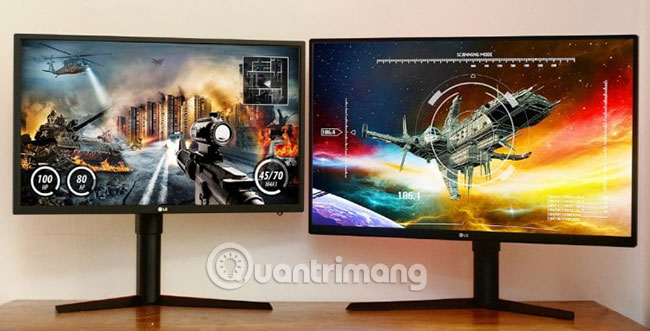What is the difference between 60Hz, 144Hz and 240Hz refresh rates?
When you look to buy a new monitor, there are many factors to consider such as size, resolution or frame rate. But one factor you may have heard is refresh rate.
So what exactly is the refresh rate and is it important to you? Let's find out with TipsMake.com through the following article!
What is Refresh Rate? Why is it important?
- What is refresh rate?
- Why is the refresh rate important?
- Problems with Screen Tearing
- Who benefits from the screen with a high refresh rate?
- Is the screen with high refresh rate worth the money?
- What about other upgrades?
- What is the most important factor when choosing a monitor?
What is refresh rate?
The refresh rate concept is mentioned by TipsMake.com in the article: What does the Refresh Rate parameter on the computer screen, TV mean?

If you've ever experienced trying to watch videos over a slow Internet connection, you'll see that the video looks very messy, jumping from frame to frame. The reason is because the refresh rate is low. The high refresh rate screen is capable of playback at higher frame rates (this makes the motion look smoother).
The standard basic screen is 60Hz, but you can get a higher refresh rate screen, 144Hz or even 240Hz.
Why is the refresh rate important?
So if you want your movie and game to look better, do you just need to buy a higher refresh rate screen? Not really.
Refresh rate is the maximum speed at which the screen can change images. But whether a program actually changes output quickly or not depends on its frame rate. Frame rate means the number of video frames sent to the screen every second.
To take advantage of the screen with a higher refresh rate, the computer must send data to the screen much faster. Most applications are not affected by the refresh rate. Movies are projected at 24 frames per second (fps), so even a basic 60Hz screen can handle well. High refresh rate does not make your video look better.
Refresh rate is really important when you're playing a game. Since games create data sent to the screen on the graphics card, if you have a graphics card fast enough, it can send data to the screen more quickly. This means you can play games at a higher frame rate, such as 100fps or more.
Problems with Screen Tearing

Because frame rates and refresh rates are often different, a common problem when playing games on a PC that you may encounter is the tearing screen phenomenon. This happens when the graphics card sends frames at a higher speed than the screen can handle. If you try to play a game at a high frame rate on a low refresh rate screen, you will encounter this phenomenon. The screen looks like it has just been half loaded or torn in the middle.
To avoid this, games are usually automatically limited to the refresh rate of the screen. So if you have a refresh rate of 60Hz, your games should not run at speeds higher than 60fps.
There are many solutions to this problem such as G-Sync, V-Sync and Freesync.
Who benefits from the screen with a high refresh rate?
The main group will benefit from a screen with a high refresh rate as eSports players. For those who play games such as Counter-Strike GO or Overwatch, the higher refresh rate will make the image smoother and help track fast-paced action more easily. Some people say that a higher refresh rate makes it easier to target because the moving targets are smooth, but this varies from person to person, based on how good the vision is.

When our eyes see a series of frames, the brain will 'fill' the changes from frame to frame, making the frames look like a continuous video instead of a series of still images like the original. their true nature. If more information is sent to the brain in the form of more regular frames, the motion will look sharper.
Another important issue when playing games is the lag or delay between user-generated input (such as moving the mouse or pressing a key) and the input is recognized by the game. A high refresh rate screen can reduce lag because the input and changes reflected on the screen take place in a very short time. This difference is very small, in milliseconds, but can make a difference in competitive situations.
For really serious professionals and gamers, every advantage even the smallest is very important. And it is true that, if you are not afraid to withdraw most, gamers can benefit from a high refresh rate screen.
But what about other users? If you are a normal home gamer, is the high refresh rate worth the extra money?
Is the screen with high refresh rate worth the money?

When deciding whether to buy a monitor with a high refresh rate, you should consider what you can spend on.
A typical 240Hz refresh rate screen, at 1080p resolution and 24.5 "size, will cost you about $ 400 (over 9,000,000 VND). Also for that $ 400, you can buy a 27 '' larger screen at 1440p resolution and 144Hz refresh rate is still impressive. Or if the refresh rate is not important to you, you can buy a large 34 '' screen, with a 4K resolution and a standard 60Hz refresh rate, still for $ 400.
What about other upgrades?
Besides, you can buy a cheaper monitor for $ 100 (about 2,300,000 VND) and get the $ 300 you save to invest in a better graphics card. For example, the price of $ 300 (VND 6.9 million) will allow you to upgrade from the impressive GeForce RTX 2070 (cost about $ 550 / 12,800,000 VND) to the GeForce RTX 2080 (costing about $ 800 / VND 18,650,000).
Remember that your screen needs refresh rate fast enough to display more frames every second. So, upgrading to a super fast graphics card doesn't mean anything, if you only have a 60Hz monitor. But you can see more benefits from combining a mid-range 144Hz monitor and a top-end graphics card, rather than a combination of a 240Hz display and inferior graphics card.
What is the most important factor when choosing a monitor?
When choosing to buy a new monitor, what kind of monitor you should buy depends on what you will use it for.
If you want a screen for the living room and plan to watch movies or play games while sitting on the couch, with a distance of 8 to 10 feet (2.5 - 3m), it's best to choose one Big screen. You are not near the screen to really see a high resolution or benefit from a high refresh rate, so choosing a larger screen size may be a smarter option.
If you want a monitor on your desk, in most cases you will want a high resolution screen for sharper images. This will be useful when you watch movies, perform productivity tasks and need lots of space on the desktop or play multiple games.
Finally, if you want to have a screen that is primarily for gaming and serious about your gameplay, you can choose the screen with a higher refresh rate. Some people find a higher refresh rate that provides a smoother feel than a low refresh rate, while others don't see much difference. Try finding a screen with a high refresh rate at the store and see if it is useful to you.
Refresh rate is really only important for professional gamers. Ordinary gamers and PC users generally should invest in a large screen, with a higher resolution.
Wish you find the right choice!
You should read it
- What does the Refresh Rate parameter on the computer screen, TV mean?
- Why is 90Hz screen a top factor when choosing a smartphone in 2020?
- How to turn on 144Hz (or higher) on dedicated gaming screens
- How to view and change the refresh rate of the Windows screen
- This is the smartphone with the cheapest 120Hz refresh rate in the world at the present time
- Tips to make the most of the image refresh rate on your computer screen
 Top 10 best computer mouse 2019
Top 10 best computer mouse 2019 Learn about the CPU socket
Learn about the CPU socket Windows 10 mouse problems and workarounds
Windows 10 mouse problems and workarounds Instructions on how to fix a computer mouse click double click
Instructions on how to fix a computer mouse click double click Learn about some Battery technologies
Learn about some Battery technologies Logitech Pro mouse game is good?
Logitech Pro mouse game is good?